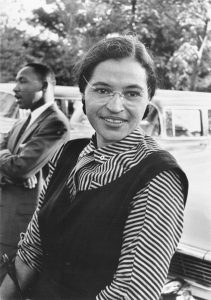 This is a guest post by Robin Washington. Washington grew up in Chicago in a family of black and Jewish civil rights activists. A nationally award-winning journalist and commentator/guest on National Public Radio, MSNBC, Fox News, ABC News, CNN and the BBC, Washington is Editor of the Duluth News Tribune.
This is a guest post by Robin Washington. Washington grew up in Chicago in a family of black and Jewish civil rights activists. A nationally award-winning journalist and commentator/guest on National Public Radio, MSNBC, Fox News, ABC News, CNN and the BBC, Washington is Editor of the Duluth News Tribune.
There are hundreds of thousands, if not millions, of people who can say they’ve seen Rosa Parks in person, making anything I have to add a drop in an ocean. Though shy and retiring, wherever she went she drew crowds and turned heads, like the wave in a mega-stadium or the entourage mobbing a movie star. But unlike those figures, she also turned hearts.
I last saw her in 1998, at the funeral of U.S. Appeals Court Judge A. Leon Higginbotham Jr. in Boston. Everyone who was anyone in America’s civil rights struggle was there, and as the mother of that movement walked into Peoples Baptist Church, the wave came in a multi-hued throng that amassed around her. As she slowly stepped forward it parted, like the sea around Moses, giving some the courage to extend a tentative hand.
“Mrs. Parks, I just want to thank you,” I remember one woman saying, echoed by the thank yous of countless others.
That included the powerful as well as the powerless. In one of her numerous biographies, she related meeting Nelson Mandela during the South African leader’s 1990 world tour following his release from 27 years of prison. Exiting a plane amid a crowd chanting his name, Mandela spied her and began chanting her name: “Rosa Parks. Rosa Parks. Rosa Parks!”
Perhaps more than anyone else, Parks wondered about her celebrity stemming from her single act of courage. “As time has gone by, people have made my place in the civil rights movement bigger and bigger,” she wrote in a 1992 autobiography, adding, “Interviewers still only want to talk about that one evening in 1955 when I refused to give up my seat on the bus.”
Whether by luck or otherwise, I knew better than to ask her that when I met her in Detroit, her adopted home, the year she wrote those words. Instead, I wanted to know what she remembered of other civil rights figures and incidents from the struggle’s earliest days about which I was producing a PBS documentary. Showing her a series of photos, I asked if she recognized any of those in them. As I remember — I didn’t take notes — she replied:
“That’s Glenn Smiley.”
“Yes, yes,” I responded excitedly over the picture of the pacifist white Methodist minister who tutored the young Rev. Martin Luther King on Gandhian nonviolence, and later shared a seat with him for the first integrated bus ride in Montgomery.
“How is Glenn?”
“He’s fine. He says hello.” (Well, he hadn’t actually, though I was sure he would have wanted me to). “Do you remember these people?” I asked, pointing to a snapshot of Freedom Ride pioneers Jim Farmer, George Houser and Bayard Rustin, with an unidentified woman I was hoping she could name.
“That’s Jim Farmer. How is Jim?”
“He’s fine, too. Did you know George Houser?”
She nodded.
“And Bayard Rustin?”
“How is Jim?”
“He’s fine. But you knew Bayard, didn’t you?”
“How is Glenn?”
Though she was of advanced years, this was anything but Alzheimer’s or senility speaking. She very well knew who Bayard was, and of his brilliance as an tactician who would organize the 1963 March on Washington as well as the danger to the movement posed by his then too-taboo-to-mention homosexuality, followed by his split with the orthodoxy of America’s black leadership in later years. For whatever reason, it seemed, she just didn’t like him and wasn’t going to offer diplomatic recognition to his image.
But it was that human element that personified Rosa Parks. An icon to the world, she was an everyday person who had her likes and dislikes and took the bus to where she had to go. Indeed, though she later worked in the Detroit office of a powerful congressman, she still took the bus. One can only wonder what went through the minds of bus drivers black and white as she boarded.
Yet do not mistake ordinary for naïveté. She prepared for, executed and accepted her role as mother of a movement, and did so flawlessly.
“Mrs. Parks,” so many of us have said, both too many times and not enough, “I just want to thank you.”
Originally published as “Rosa Parks turned hearts as well as heads” in the Duluth News Tribune, San Jose Mercury News, St. Paul Pioneer Press and Bay State Banner on Oct. 25, 26, 27, 2005.
(Photo: Wikimedia Commons)


1 comment